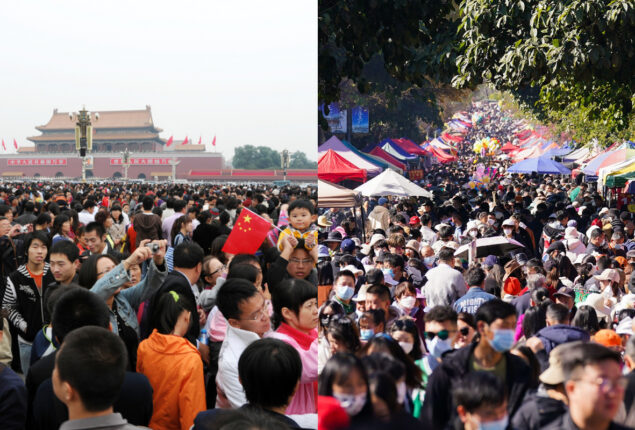China’s 2022 Economic Growth Slows Due to Coronavirus Restrictions
Beijing abruptly changed its tight zero-Covid stance last month. The world's second-largest...

China’s population has declined for the first time in 60 years
China’s population has decreased for the first time in 60 years with a record-low national birth rate of 6.77 births per 1,000 people.
The population decreased by 850,000 from 2021 to 2022, reaching 1.4118 billion.
Years of dropping birth rates in China have prompted a plethora of programs to attempt and reverse the trend.
However, it entered what one official called a “period of negative population growth” seven years after abandoning the one-child policy.
According to data issued on Tuesday by China’s National Bureau of Statistics, the birth rate fell to 7.22 in 2022 from 7.52 in 2021.
In contrast, the United States and the United Kingdom both had 10.08 births per 1,000 inhabitants in 2021. India, which is on track to surpass China as the world’s most populated nation, had a birth rate of 16.42 for the same year.
For the first time ever, deaths also exceeded births in China last year. The nation had 7.37 deaths per 1,000 inhabitants, up from 7.18 the year before, which was the highest mortality rate recorded since 1976.
An impending demographic catastrophe, which would eventually reduce China’s labor force and raise the cost of healthcare and other social security benefits, had been predicted by earlier government data.
China’s population was expanding at its slowest rate in decades, according to results of an every ten years census that was revealed in 2021. Other East Asian nations like Japan and South Korea are also experiencing population decline and aging populations.
Yue Su, the lead economist at the Economist Intelligence Unit, predicts that this trend will continue and possibly get worse after Covid. Ms. Su is one of many analysts who predict that China’s population will continue to decline through 2023.
“The high youth unemployment rate and weaknesses in income expectations could delay marriage and childbirth plans further, dragging down the number of newborns,” she added.
And because of Covid infections, she added, the mortality rate in 2023 is probably going to be higher than it was before the epidemic. Since giving up its zero-Covid policy last month, China has witnessed an increase in instances.
The contentious one-child policy, which was implemented in 1979 in an effort to restrict population growth, has played a significant role in shaping China’s demographic trends over time. Families that disobeyed the regulations paid fines and in some cases even lost their jobs. The strategy also resulted in forced abortions and a reportedly skewed gender ratio beginning in the 1980s, in a society where boys have traditionally been preferred over girls.
In 2016, the rule was changed to allow married couples to have two children. The Chinese government has recently provided additional incentives, like as tax breaks and improved maternal healthcare, in an effort to stop or at least moderate the decline in the birth rate.
However, there was no persistent rise in births as a result of these efforts. According to some analysts, this is because policies that promoted parenthood did not include measures to lessen the strain of childcare, such as more support for working women or increased access to education.
Chinese President Xi Jinping called increasing birth rates a top priority in October 2022. In response to the aging population of the nation, Mr. Xi declared at the once every five years Communist Party Congress in Beijing that his administration will “pursue a proactive national policy.”
In addition to providing incentives for having children, Bussarawan Teerawichitchainan, director of the National University of Singapore’s Centre for Family and Population Research, suggested that China should enhance gender equality in homes and workplaces.
Scandinavian nations have demonstrated how such actions might raise reproduction rates, she continued.
Paul Cheung, a former head statistician for Singapore, claims that China has “enough staff” and “a lot of lead time” to handle the demographic crisis.
“They are not in a doomsday scenario right away,” he said.
Increasing birth rates alone, according to observers, won’t fix the issues causing China’s declining growth.
According to Stuart Gietel-Basten, a professor of public policy at The Hong Kong University of Science and Technology, increasing fertility won’t raise productivity or domestic consumption over the long run.
“How China will respond to these structural issues would be more crucial.”
Catch all the China News, International News, World News, Breaking News Event and Latest News Updates on The BOL News
Download The BOL News App to get the Daily News Update & Follow us on Google News.